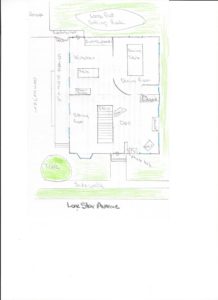When I lived in Groton, Connecticut, my sister and I shared a bedroom on the second floor. After my mother told us to turn out the bedroom light at night, when she had gone back down the stairs, we would quietly take out flashlights and read under the covers. Inevitably, within minutes, my mother would call up the stairs, “Turn off the flashlights and get some sleep.” At first, I thought she might be assuming we were reading but didn’t really know. This was disproved when she never called up the stairs when we weren’t reading – not even once. I couldn’t figure out how she could see up the stairs, around a couple of corners, and through a door. The mystery was beyond my first grade mind to grasp. It wasn’t until years later that she told me: every night, she would go outside to bring our bikes inside. As she stood in dark, she could see the flashlight glow through our bedroom window. An outside perspective showed what was invisible from within.
This memory brings a smile and a reminder: sometimes an outsider’s view is necessary to solve an insider mystery. Also: the smallest light illuminates not only what I wish to see, but casts a light far beyond my ken.
[This is part of a larger series. For more, please click ” No place like home(s)” above.]



